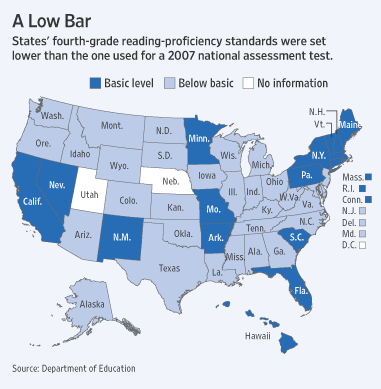[and the wordless picture books have been a big hit, too!!…Will Fitzhugh]
“The staff cobbled together an approach that incorporates methods and materials used with younger children, such as art projects and wordless picture books, into high-school-level instruction. The idea is to use engaging activities and easy-to-access materials as door-openers to more complex subject matter.
The result is a high school that ‘looks more like an elementary school,’ Mr. Ledbetter said, because teachers find that letting students sketch, cut out, or fold their ideas seems to work well.”
Catherine Gewertz:
The sheep’s-brain dissections are going rather well. Scalpels in hand, high school students are slicing away at the preserved organs and buzzing about what they find. It’s obvious that this lesson has riveted their interest. What’s not so obvious is that it has been as much about literacy as about science.
In preparing for her class in human anatomy and physiology to perform the dissections, Karen Stewart had the students read articles on the brain’s structure and use computer-presentation software to share what they learned. She used “guided notetaking” strategies, explicitly teaching the teenagers how to read the materials and take notes on key scientific concepts. She reinforced those ideas with more articles chosen to grab their interest, such as one on how chocolate affects the brain.
The class also watched and discussed a recent episode of the hit television show “Grey’s Anatomy,” about a patient with an injury to one side of the brain. The students’ work is graded not just on their grasp of the science, but also on the quality of their research and writing about it.
Ms. Stewart isn’t the only teacher who weaves literacy instruction into classes here at Buckhorn High School. It pops up on every corridor. A teacher of Spanish shows his students a self-portrait of the Mexican painter Frida Kahlo and asks what cues it conveys about her culture. A physical education teacher brings his class to the school library to study body mass. And a mathematics teacher burrows into the Latin roots of that discipline’s vocabulary to help students see their related meanings, and uses “concept maps”–visual depictions of ideas–to help them grasp an idea’s steps or parts.
Literacy is shot through everything at this 1,350-student Alabama school in a former cotton field 10 miles south of the Tennessee state line. It’s been an obsession for a decade, ever since school leaders tested their students and found that one-third of the entering freshmen were reading at or below the 7th grade level, many at the 4th or 5th grade level.
“Those numbers completely changed my professional life,” said Sarah Fanning, who oversees curriculum and instruction at Buckhorn High. “I couldn’t eat. I couldn’t sleep. Each of those numbers had a face, and that face went to bed with me at night.”
‘Relentless From the Beginning’
The Buckhorn staff immersed itself in figuring out how to improve student learning by boosting literacy skills in all subjects, something few high schools do now, and even fewer were doing then. That work has made the school a national model. Hosting visitors and making presentations–including at a White House conference in 2006–have become routine parts of its staff members’ schedules.
Adolescent-literacy work such as that at Buckhorn High is taking on a rising profile nationally, as educators search for ways to improve student achievement. Increasingly, scholars urge teachers to abandon the “inoculation” model of literacy, which holds that K-3 students “learn to read,” and older students “read to learn.” Older students are in dire need of sophisticated reading and writing instruction tailored to each discipline, those scholars say, and without it, they risk being unable to access more-complex material. The Carnegie Corporation of New York recently released a report urging that adolescent literacy become a national priority. (“Literacy Woes Put in Focus,” Sept. 23, 2009.)
Selected literacy resources at Buckhorn High School:
Professional Reading
Reading Reminders, Jim Burke
Deeper Reading, Kelly Gallagher
Content Area Reading, Richard R. Vacca and Jo Anne L. Vacca
I Read It, But I Don’t Get It, Cris Tovani
Do I Really Have to Teach Reading? Cris Tovani
Wordless Picture Books
Anno’s Journey, Mitsumasa Anno
Free Fall, David Wiesner
Tuesday, David Wiesner
Freight Train, Donald Crews
Zoom, Istvan Banyai
Content-Area Picture Books and Graphic Novels
Chester Comix series, Bentley Boyd
Just Plain Fancy, Patricia Polacco
Harlem, Walter Dean Myers
The Greedy Triangle, Marilyn Burns
High-Interest, Easy-to-Understand Books for Adolescents
A Child Called “It,” Dave Pelzer
Hole in My Life, Jack Gantos
Crank, Ellen Hopkins
Burned, Ellen Hopkins
The “Twilight Saga” collection, Stephenie Meyer
The “Soundings” and “Currents” series, Orca Publishing
The Bluford High series, Townsend Press
Source: Buckhorn High School
Continue reading An Alabama High School Makes Literacy a Schoolwide Job
An Alabama school that is seen as a national model shows how to teach reading and writing in every subject. →


